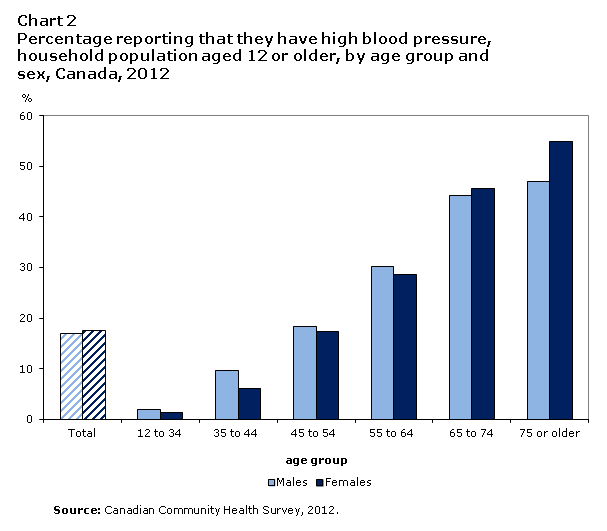High blood pressure, 2012
Archived Content
Information identified as archived is provided for reference, research or recordkeeping purposes. It is not subject to the Government of Canada Web Standards and has not been altered or updated since it was archived. Please "contact us" to request a format other than those available.
 High blood pressure, also known as hypertension, increases the risk of stroke, heart attack and kidney failure. It can narrow and block arteries, as well as strain and weaken the body’s organs.Note 1
High blood pressure, also known as hypertension, increases the risk of stroke, heart attack and kidney failure. It can narrow and block arteries, as well as strain and weaken the body’s organs.Note 1
The high blood pressure data are based on a question in the Canadian Community Health Survey that asked if respondents had been diagnosed with high blood pressure by a health professional.
In 2012, 17.4% (5.1 million) of Canadians aged 12 and older reported having high blood pressure. This was not a significant change from 2011, though it is an increase from 16.4% in 2008.
From 2001 to 2009, females were more likely than males to report that they had been diagnosed with high blood pressure. However, since 2010 there has been no significant difference between the sexes (Chart 1).
In addition, Canadians who were obese – based on respondent-reported height and weight and Health Canada guidelines on body mass index – were more likely to have high blood pressure than those who were not obese. In 2012, 33.1% of Canadians who were obese had high blood pressure, compared with 15.4% of those who were not obese.

High blood pressure rates increased with age for females across all age groups. For males, the rates increased with age up to 65 years of age, after which there is no significant difference for those 65 to 74 years of age compared to those 75 and older.
The rates of high blood pressure were similar between males and females for most age groups. However, between the ages of 35 and 44, males had higher rates of high blood pressure than females, while at 75 and older, females’ high blood pressure rates exceeded that of males (Chart 2).

The proportion of residents who reported high blood pressure was lower than the national average (17.4%) in:
- Northwest Territories (9.6%)
- Nunavut (13.1%)
The proportion of residents who reported high blood pressure that was higher than the national average in:
- Newfoundland and Labrador (22.6%)
- Prince Edward Island (20.6%)
- Nova Scotia (22.6%)
- New Brunswick (23.3%)
Residents of the other provinces and of Yukon reported rates that were about the same as the national average.
Because of the strong relationship between age and high blood pressure, provinces and territories with disproportionately younger populations are expected to have high blood pressure rates below the national average. The reverse is true for provinces and territories with older populations. To remove the effect of different age distributions when making provincial comparisons, please refer to the CANSIM table 105-0503 for the age standardized rates.
End note
- Heart and Stroke Foundation. http://www.heartandstroke.ca (accessed May 10, 2010).
References
Garriguet, Didier. 2007. “Sodium consumption at all ages.” Health Reports. Vol. 18, no. 2. May. Statistics Canada Catalogue no. 82‑003. p. 47‑52. http://www.statcan.gc.ca/pub/82-003-x/2006004/article/sodium/9608-eng.pdf (accessed May 10, 2010).
Heart and Stroke Foundation. http://www.heartandstroke.ca (accessed May 10, 2010).
Johansen, Helen. 1999. “Living with heart disease—the working—age population.” Health Reports. Vol. 10, no. 4. Spring. Statistics Canada Catalogue no. 82‑003. p. 33‑45. http://www.statcan.gc.ca/studies-etudes/82-003/archive/1999/4508-eng.pdf (accessed May 10, 2010).
Johansen, Helen, Mukund Nargundkar, Cyril Nair, Greg Taylor and Susie ElSaadany. 1997. “At risk of first or recurring heart disease.” Health Reports. Vol. 9, no. 4. Spring. Statistics Canada Catalogue no. 82‑003. p. 19‑29. http://www.statcan.gc.ca/studies-etudes/82-003/archive/1998/3683-eng.pdf (accessed May 10, 2010).
Wilkins, Kathryn, Campbell, Norman R.C., Joffres, Michel R. 2010. “Blood pressure in Canadian adults.” Health Reports. Vol. 21, no. 1. Statistics Canada Catalogue no. 82‑003. p. 1‑10.
http://www.statcan.gc.ca/pub/82-003-x/2010001/article/11118-eng.pdf (accessed April 7, 2011).
Data
Additional data from the Canadian Community Health Survey are available from CANSIM tables 105–0501 and 105-0503.
- Date modified:
